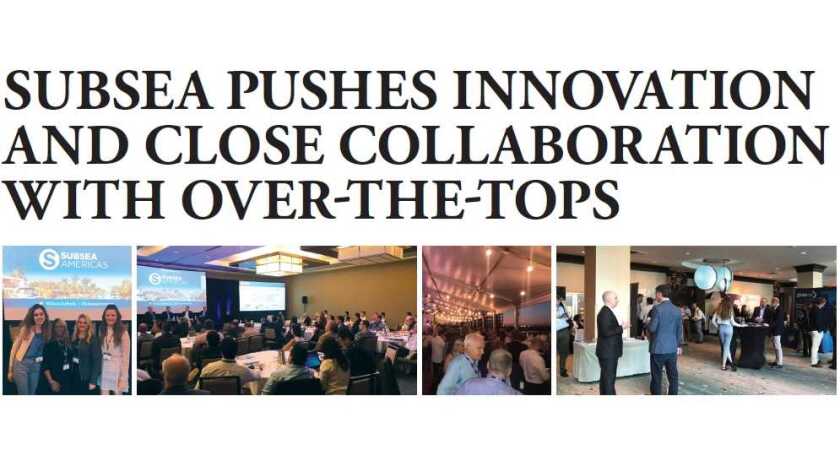The launch session featured panellists Elaine Stafford, managing partner of DRG Undersea Consulting; Rosalind Thomas, managing director and CEO of SAEx International; and Diane Sanzone, vice president of AECOM. Topics included how women can claim their own path and what unique skills they have to offer, overcoming obstacles and what attendees need from their male counterparts in order to succeed in the sector.
As the event progressed, talk unsurprisingly turned to OTT/content providers and their influence in the sector. During the content-driven cables session, moderated by Eric Handa of APTelecom, David Crowley, chief technical advisor, Microsoft, said that his focus for the company is on “taking Microsoft to the next level of connectivity as it pertains to cloud and interconnects.”
As the conversation progressed, Handa asked fellow panellist Mike Sauer, VP Americas partner and federal, Aqua Comms, about what the company looks for when beginning a new cable project. Sauer was frank in his reply saying: “Without the OTTs involved, quite frankly we don’t build the cable.”
Overall, the message from the two is one of co-existence between the OTTs and the operators, not competition. “I don’t feel any tension,” explained Crowley. “At the end of the day we’re not an operator, we’re an investor and we need the best capability for our clients who use our services.”
Sauer thinks that the relationship between the two will always work because OTTs have no desire to take up the role of operators echoed his sentiment.
“I think with regards to any OTT they want the cost model of being an owner, but they don’t want the responsibility of managing, maintaining and making sure the cable is operational at all times.”
The keynote included four industry heavyweights. Paul Scott, senior advisor at C&W Networks; Larry Schwartz, CEO of Seaborn Networks; Mike Cunningham, CEO of Crosslake Fibre and Steve Scott, CEO of Deep Blue Cable.
During the session, the four discussed how to grow Latin America and connect the hubs that exist in the region; the biggest food for thought came from Deep Blue’s Scott who said that OTTs are uninterested in the Caribbean.
“It’ll be quite some time for the OTTs to take an interest in the Caribbean. They backhaul to the US so there’s no real incentive there,” he said.
As for thoughts on how to grow the region, they all had different ideas on how best to go about it.
“By performing as an operating company,” said Schwartz. “And being receptive to market changes as well as environmental ones like the hurricanes that swept the region in 2017.”
Moving forward, Crosslake’s Cunningham is focusing on the micro, not the macro. “Our company focus is on a single route to one that has parallel projects of a full operator,” he said.
Paul Scott thinks it is all about added route diversity and network latency driven by cloud consumption, underpinned by multi-purpose hardened facilities.
“By working with Deep Blue and C&W to provide and share capacity,” chimed in Deep Blue’s Scott. “The added choice would benefit the 42 million people who live there.” As well as new economies of scale underscored by changing finance models.
Speaking of financial models, Santhosh Rao, head of telecommunications, Americas, at Natixis, was asked by moderator Andrew Lipman about what the key things he looks for when financing a new cable project. He said: “The commercial market opportunities and how viable is the business plan is.”
“Every subsea project is unique in terms of its rate of return and commercial potential,” explained Igor Skochilo, vice president of DH Capital. “But more investors need to be educated on where the industry is headed.”
What about choosing projects to invest in? Richard Lukaj, senior managing director of Bank Street, said: “Industry experience is critical. It’s a minimum requirement for us.”
As for new routes, Skochilo said that it is all about demand and existing infrastructure. However, don’t be fooled even the best equipped locations aren’t a sure thing.
“In some of the best-heeled locations we’ve seen massive disruption and that is due to the pull of some of these anchor customers,” said Lukaj.
One of the most well attended sessions was the panel on data centres. Vinay Nagpal, president of Interglobix, gave an interesting overview of the market predicting the rapid growth of edge data centres.
“I think the data centre model has evolved over the years from the traditional retail colocation model, to wholesale, to cloud-based computing to edge. Over the next five years we expect to see some explosive growth in edge data centres.”
Looking ahead, innovation is the key differentiator for the sector. NJFX founder and managing member Gil Santaliz commented: “Don’t expect great results doing average things.”






